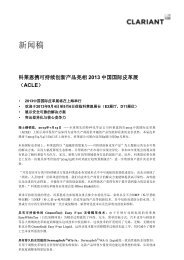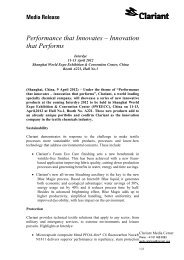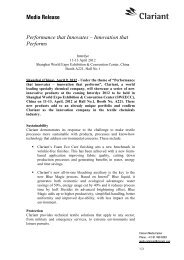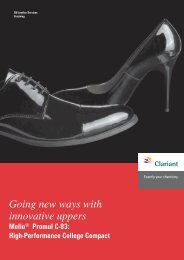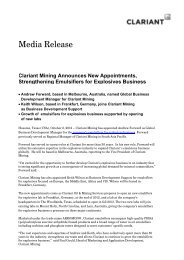CESA BROCHURE - Clariant
CESA BROCHURE - Clariant
CESA BROCHURE - Clariant
- No tags were found...
Create successful ePaper yourself
Turn your PDF publications into a flip-book with our unique Google optimized e-Paper software.
Processing Aids, Mold Release,Cleaning Agents & Regrind OptimizationProcessing AidsDuring the extrusion process, <strong>CESA</strong>processmasterbatches coat the innersurface of the die, reducing the frictionbetween the melt and the metal andallowing polymers to extrude moreeasily. By lowering the friction andeliminating or reducing melt-fractureand die buildup, <strong>CESA</strong>-process enablesdifficult-to-process materials such asnarrow-molecular-weight LLDPE andLLDPE-rich blends to run on existingextrusion lines.An example is <strong>CESA</strong>-process AEH603, amasterbatch based on fluoroelastomers.Developed for LLDPE and metallocenefilm extrusion, it can be used in conjunctionwith high quantities of fillers,antiblocking agents and inorganicpigments. In addition to eliminatingmelt-fracture and reducing die buildup,the use of this masterbatch enhancesthe optical properties of the film byimproving its transparency.Mold ReleaseThe addition of <strong>CESA</strong>-release masterbatchesto polymers during processingprevents parts from sticking to the moldcavity, facilitating their removal. Otheradvantages include reduced cycle timesand increased machine output.Cleaning AgentsPlastics processing periodically requirescomplete removal of thermo-oxidizeddeposits from extruders and injectionmolding machines. <strong>CESA</strong>-cleanmasterbatches permit fast, economicalcleaning of machinery to facilitate coloror resin changes with minimal downtimeand loss of virgin material.One example is <strong>CESA</strong>-clean 9104masterbatch, a balanced mixture ofsurface-active substances and fillerswith a low abrasive power, based onlow-density polyethylene. Widely usedfor purging extruders and injectionpresses, the masterbatch allows quickchanges of color and materials ofvarying viscosities.Regrind OptimizationRe-using post-industrial or post-consumerpolyester regrind has typicallybeen limited due to the adverse effectsof heat and moisture on the virgin resin.<strong>CESA</strong>-extend masterbatches utilizean oligomeric reactant to repair thedamage and restore the resin’s IntrinsicViscosity (IV). Processors can then usehigher proportions of recycled resinwhile maintaining the same processingproperties as virgin PET.A series of <strong>CESA</strong>-extend masterbatcheswith a variety of carrier resins is availablefor clear and opaque applications.These include extruded polyester sheetand strapping, stretch blow-moldedPET bottles, foamed PET sheet or filmand pelletizing undried recycle or scrap.15



